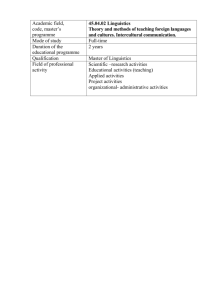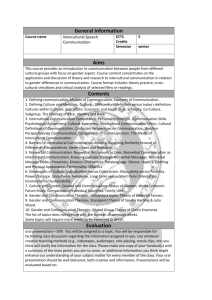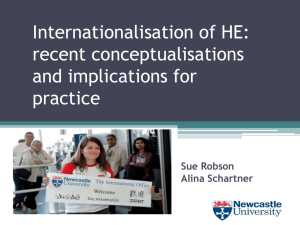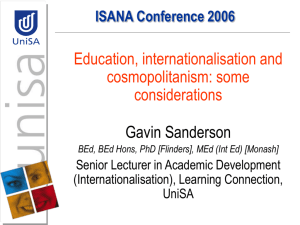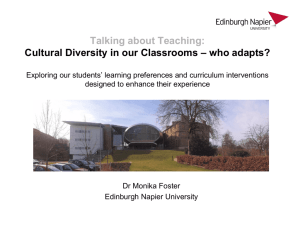Reasonable Adjustments: Overview
advertisement
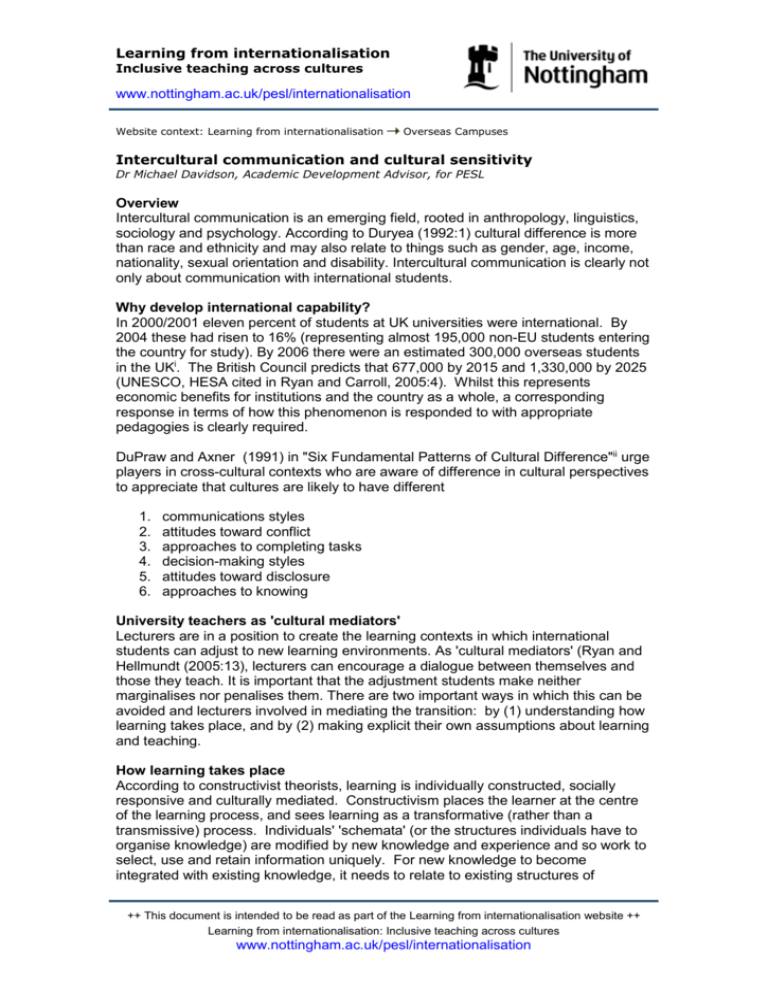
Learning from internationalisation Inclusive teaching across cultures www.nottingham.ac.uk/pesl/internationalisation Website context: Learning from internationalisation Overseas Campuses Intercultural communication and cultural sensitivity Dr Michael Davidson, Academic Development Advisor, for PESL Overview Intercultural communication is an emerging field, rooted in anthropology, linguistics, sociology and psychology. According to Duryea (1992:1) cultural difference is more than race and ethnicity and may also relate to things such as gender, age, income, nationality, sexual orientation and disability. Intercultural communication is clearly not only about communication with international students. Why develop international capability? In 2000/2001 eleven percent of students at UK universities were international. By 2004 these had risen to 16% (representing almost 195,000 non-EU students entering the country for study). By 2006 there were an estimated 300,000 overseas students in the UKi. The British Council predicts that 677,000 by 2015 and 1,330,000 by 2025 (UNESCO, HESA cited in Ryan and Carroll, 2005:4). Whilst this represents economic benefits for institutions and the country as a whole, a corresponding response in terms of how this phenomenon is responded to with appropriate pedagogies is clearly required. DuPraw and Axner (1991) in "Six Fundamental Patterns of Cultural Difference"ii urge players in cross-cultural contexts who are aware of difference in cultural perspectives to appreciate that cultures are likely to have different 1. 2. 3. 4. 5. 6. communications styles attitudes toward conflict approaches to completing tasks decision-making styles attitudes toward disclosure approaches to knowing University teachers as 'cultural mediators' Lecturers are in a position to create the learning contexts in which international students can adjust to new learning environments. As 'cultural mediators' (Ryan and Hellmundt (2005:13), lecturers can encourage a dialogue between themselves and those they teach. It is important that the adjustment students make neither marginalises nor penalises them. There are two important ways in which this can be avoided and lecturers involved in mediating the transition: by (1) understanding how learning takes place, and by (2) making explicit their own assumptions about learning and teaching. How learning takes place According to constructivist theorists, learning is individually constructed, socially responsive and culturally mediated. Constructivism places the learner at the centre of the learning process, and sees learning as a transformative (rather than a transmissive) process. Individuals' 'schemata' (or the structures individuals have to organise knowledge) are modified by new knowledge and experience and so work to select, use and retain information uniquely. For new knowledge to become integrated with existing knowledge, it needs to relate to existing structures of ++ This document is intended to be read as part of the Learning from internationalisation website ++ Learning from internationalisation: Inclusive teaching across cultures www.nottingham.ac.uk/pesl/internationalisation knowledge in order to become 'understood' by learner. When new knowledge and experience fails to integrate into existing structures (and to modify or confirm them), learners experience 'cognitive dissonance' or 'academic (culture) shock'. This is a critical stage in the process of international students becoming at home in a new learning environment. Such dissonance may be a point of new learning or growth, or can result in the learner disengaging. The more lecturers are able to engage with such learners, perhaps by providing small group interaction where new opportunities for learning and discussion are available, the greater the chance that these learners will integrate new knowledge or academic rules successfully. It might be worthwhile lecturers consider designing learning environments that are inclusive and in which learning is constructed through interaction, rather than through transmission of information. Inclusive learning environments are therefore personally transformative because information is multidimensional, flowing in several directions, and not simply from the lecturer to the learner. Intercultural learning is particularly conducive to developing such environments. Intercultural learning is an important component of the higher education experience because it provides exposure (for both international and home students) to cultural diversity on a cognitive level. Intercultural interaction forces both students and lecturers to adapt to a different setting. Steir 2002:4iii describes intercultural education as four parallel and interconnected journeys: (1) an academic journey in which students must adapt to a new setting, with its own academic culture, teaching styles, learning environment, social norms, assessment system; (2) a cultural journey, in which students must come to terms with a new national culture, and the fact that this is rarely homogenous nor does it conform to any stereotypical views that have been held; (3) an intellectual journey in which students should become aware of paradigm and worldview differences, and hopefully become critically reflective with respect to ethnocentricism and other prejudices. This will encourage them to move away from instrumentalist learning, to one in which they can cast themselves as having an 'outsider's perspective'; (4) an emotional journey because mixing with different cultural identities can produce feelings of aloneness when feeling like an 'alien' or 'foreigner'. International students often learn to cope with difficult personal emotional responses. Also conceptualising interaction between cultures in personal experience, Fantini (2000:30iv) distinguishes four developmental levels with respect to those who interact formally across cultures in the pursuit of education: Level I: Educational Traveler - e.g., participants in short term exchange programs/4-6 weeks Level II: Sojourner - longer cultural immersion, e.g., interns and participants in college semester abroad programs and intercultural internships of long duration, 4-8 months Level III: Professional - staff who work in an intercultural or multicultural context; e.g., School for International Training and World Learning employees, alumni, project staff ++ This document is intended to be read as part of the Learning from internationalisation website ++ Learning from internationalisation: Inclusive teaching across cultures www.nottingham.ac.uk/pesl/internationalisation Level IV: Intercultural/Multicultural Specialist - individuals involved in training, educating, consulting, and advising international students, overseas directors, and cross-cultural trainers. How people learn to communicate across inter-cultural barriers Bennett (1993:7)v developed a model examining the progression made from ethnocentricism (all cultures are like mine) to ethnorelativism (cultures are relative to each other), in which he proposed the following six steps: 1. Denial: Does not recognise cultural differences; inability to construe difference 2. Defence: Recognises some differences, but sees them as negative 3. Minimisation: Unaware of projection of own cultural values; sees own values as superior, focuses on superficial differences usually insisting people are basically the same; 4. Acceptance: shifts perspectives to understand that the same "ordinary" behaviour can have different meanings in different cultures - beginning of ability to interpret cultural phenomena, contextually 5. Adaptation: Can evaluate other's behaviour from own frame of reference and can adapt behaviour to fit the norms of a different culture. This marks the beginning of ability to communicate interculturally, and there is an effective use of empathy to understand difference; 6. Integration: Can shift frame of reference and deal with resulting identity issues so that bicultural or multicultural values develop. In order to succeed in communicating across cultural barriers, one would need to at least level four, but preferably to level five according to his view. Dr Michael Davidson November 2009 i <http://news.bbc.co.uk/1/hi/education/4917642.stm> Accessed: 13 August 2009. ii DuPraw, M.E., and Axner, M. (2001) "Working on Common Cross-cultural Communication Challenges" 1001. <http://www.pbs.org/ampu/crosscult.html#FTNTS> Accessed: 25 August 2007. iii Steir, J. (2002) Internationalisation in higher education: unexplored possibilities and unavoidable challenges. <http://www.leeds.ac.uk/educol/documents/00002342.htm> Accessed: 15 October 2007. iv Fantini, Alvino E. (2000) "A Central Concern: Developing Intercultural Competence". In Fantini, Alvino E. (Ed.) About Our Institution p25-42. SIT Occasional Papers Series. Brattleboro, VT: The School for International Training. <http://www.sit.edu/publications/docs/competence.pdf> Accessed: 26th October 2007. v Bennett, M. (1993) "Toward ethnorelativism: a developmental model of intercultural sensitivity," in R.M. Paige (Ed.) Education for the Intercultural Experience Yarmouth, ME: Intercultural press, p7. ++ This document is intended to be read as part of the Learning from internationalisation website ++ Learning from internationalisation: Inclusive teaching across cultures www.nottingham.ac.uk/pesl/internationalisation



